-
PASADENA, Calif. - Earlier today, just hours after NASA's Curiosity rover landed on Mars, a select group of images taken by the onboard Mars Descent Imager, or MARDI, were beamed back to Earth. The 297 color, low-resolution images, provide a glimpse of the rover's descent into Gale Crater. They are a preview of the approximately 1,504 images of descent currently held in the rover's onboard memory. When put together in highest resolution, the resulting video is expected to depict the rover's descent from the moment the entry system's heat shield is released through touchdown.
"The image sequence received so far indicates Curiosity had, as expected, a very exciting ride to the surface," said Mike Malin, imaging scientist for the Mars Science Lab mission from Malin Space Systems in San Diego. "But as dramatic as they are, there is real other-world importance to obtaining them. These images will help the mission scientists interpret the rover's surroundings, the rover drivers in planning for future drives across the surface, as well as assist engineers in their design of forthcoming landing systems for Mars or other worlds."
The MARDI camera is located on the chassis of the Curiosity rover. Just before the heat shield fell away, MARDI began its imaging task. The images selected for early downlink to Earth were taken at different points in Curiosity's final descent toward the surface. One of the earliest images shows the entry vehicle's heat shield 50 feet (15 meters) and falling away after separating from the vehicle three seconds before. A set of images demonstrates some of the gyrations Curiosity went through while on the parachute. Another remarkable set of images depicts the final moments leading up to landing, where the exhaust from four of the descent stage's 742 pounds of thrust rockets billow up dust from the Martian surface.
"A good comparison is to that grainy onboard film from Apollo 11 when they were about to land on the moon," said Malin.
Those MARDI images downlinked so far are low-resolution thumbnails, 192 by 144 pixels. In the months ahead, as communications between rover and Earth become more robust, full-frame images 1,600 by 1,200 pixels in size, are expected to provide the most complete and dramatic imagery of a planetary landing in the history of exploration.
The mission also released a higher-resolution Hazcam image of their target, the mountain in the middle of Gale Crater informally titled Mount Sharp.
-
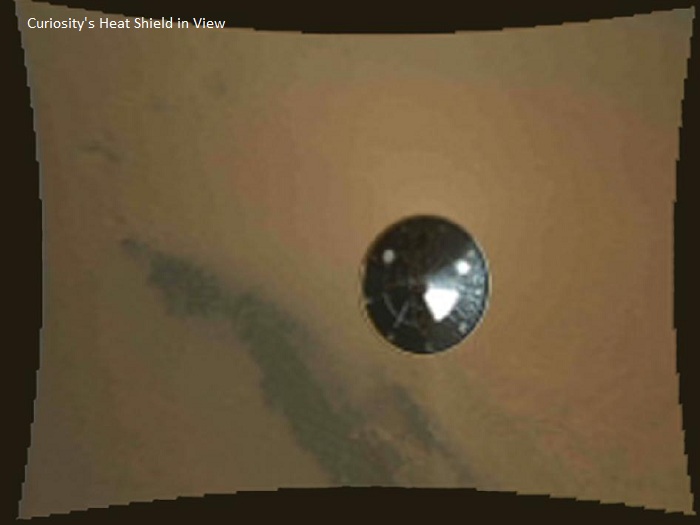
Curiosity's Heat Shield in View
This color thumbnail image was obtained by NASA's Curiosity rover during its descent to the surface of Mars on Aug. 5 PDT (Aug. 6 EDT). The image was obtained by the Mars Descent Imager instrument known as MARDI and shows the 15-foot (4.5-meter) diameter heat shield when it was about 50 feet (16 meters) from the spacecraft. It was obtained two and one-half minutes before touching down on the surface of Mars and about three seconds after heat shield separation. It is among the first color images Curiosity sent back from Mars. The resolution of all of the MARDI frames is reduced by a factor of eight in order for them to be promptly received on Earth during this early phase of the mission. Full resolution (1,600 by 1,200 pixel) images will be returned to Earth over the next several months as Curiosity begins its scientific exploration of Mars.
The original image from MARDI has been geometrically corrected to look flat.
Curiosity landed inside of a crater known as Gale Crater.
-
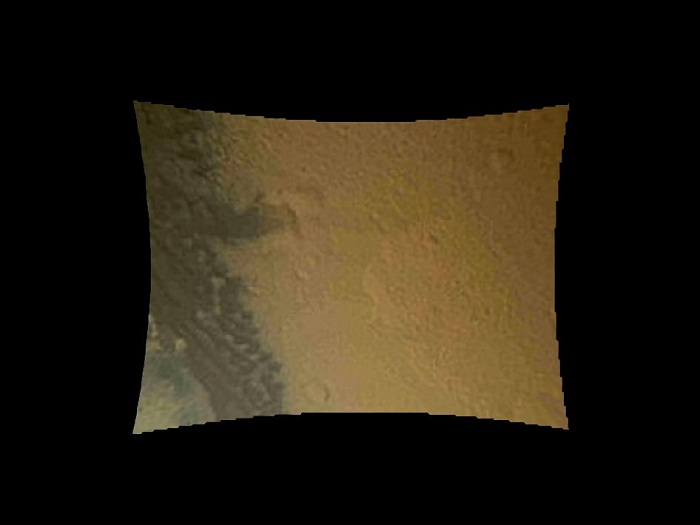
Martian Surface Below Curiosity
This color thumbnail image was obtained by NASA's Curiosity rover during its descent to the surface of Mars on Aug. 5 PDT (Aug. 6 EDT). This image from Curiosity's Mars Descent Imager reveals surface features including relatively dark dunes, degraded impact craters and other geologic features including small escarpments that range in size from a few feet (meters) to many tens of feet (meters) in height. The image was obtained one minute 16 seconds before touchdown. This is but one of hundreds of frames that were acquired during the descent to the surface.
The original image from MARDI has been geometrically corrected to look flat.
Curiosity landed inside of a crater known as Gale Crater. Image credit: NASA/JPL-Caltech/MSSS
-
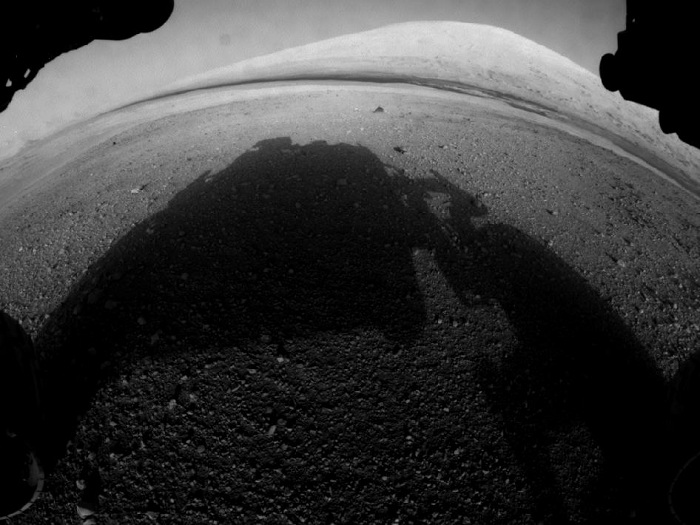
Curiosity's Early Views of Mars
This image shows one of the first views from NASA's Curiosity rover, which landed on Mars the evening of Aug. 5 PDT (early morning hours Aug. 6 EDT). It was taken through a "fisheye" wide-angle lens on one of the rover's Hazard-Avoidance cameras. These engineering cameras are located at the rover's base. As planned, the early images are lower resolution. Larger color images are expected later in the week when the rover's mast, carrying high-resolution cameras, is deployed. Image credit: NASA/JPL-Caltech
-
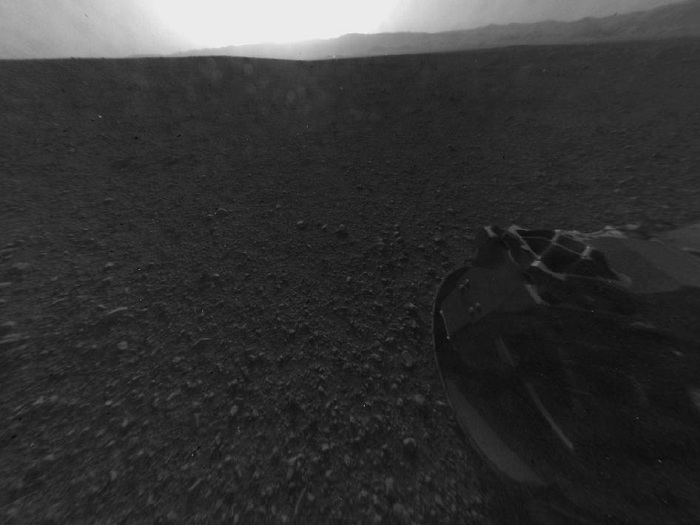
Looking Back at the Crater Rim
Part of the rim of Gale Crater, which is a feature the size of Connecticut and Rhode Island combined, stretches from the top middle to the top right of the image. One of the rover's wheels can be seen at bottom right.
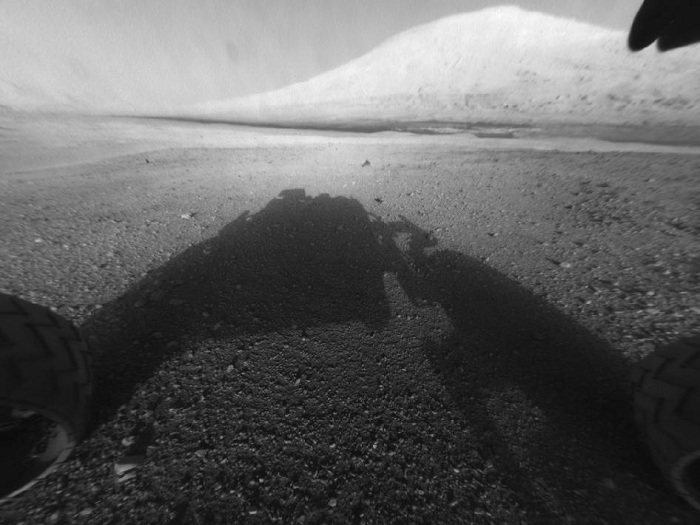
Behold Mount Sharp!
This image taken by NASA's Curiosity shows what lies ahead for the rover -- its main science target, Mount Sharp. The rover's shadow can be seen in the foreground, and the dark bands beyond are dunes. Rising up in the distance is the highest peak Mount Sharp at a height of about 3.4 miles, taller than Mt. Whitney in California. The Curiosity team hopes to drive the rover to the mountain to investigate its lower layers, which scientists think hold clues to past environmental change.
This image was captured by the rover's front left Hazard-Avoidance camera at full resolution shortly after it landed. It has been linearized to remove the distorted appearance that results from its fisheye lens. Image credit: NASA/JPL-Caltech
-
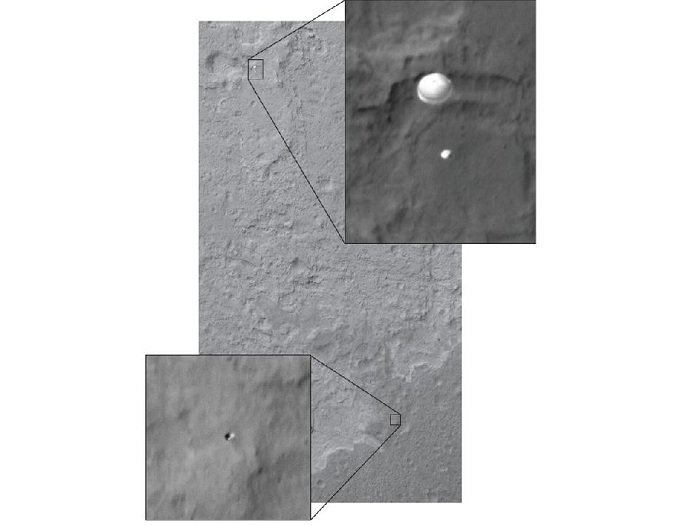
Curiosity Sails to Mars as Heat Shield Falls Away
Late last night, in the morning hours of Aug. 6, as NASA's Curiosity rover fell to the surface of Mars, NASA's Mars Reconnaissance Orbiter (MRO) captured an image of the rover gliding on its parachute. The image was taken with the orbiter's High-Resolution Imaging Science Experiment (HiRISE) camera.
Today, the MRO team located another object in this image -- not present in prior images of the same region -- which is the right size to be the rover's heat shield. The heat shield was ejected from the rover and its back shell before this image was taken. The team thinks the heat shield is still in free flight, because, if it were to have already hit the surface, it would have kicked up a dust cloud. The HiRISE image of NASA's Phoenix lander on its parachute also captured the heat shield in free fall.
HiRISE is one of six instruments on NASA's Mars Reconnaissance Orbiter. The University of Arizona, Tucson, operates the orbiter's HiRISE camera, which was built by Ball Aerospace & Technologies Corp., Boulder, Colo. NASA's Jet Propulsion Laboratory, a division of the California Institute of Technology in Pasadena, manages the Mars Reconnaissance Orbiter Project for NASA's Science Mission Directorate, Washington. Lockheed Martin Space Systems, Denver, built the spacecraft.
Image credit: NASA/JPL-Caltech/Univ. of Arizona
-
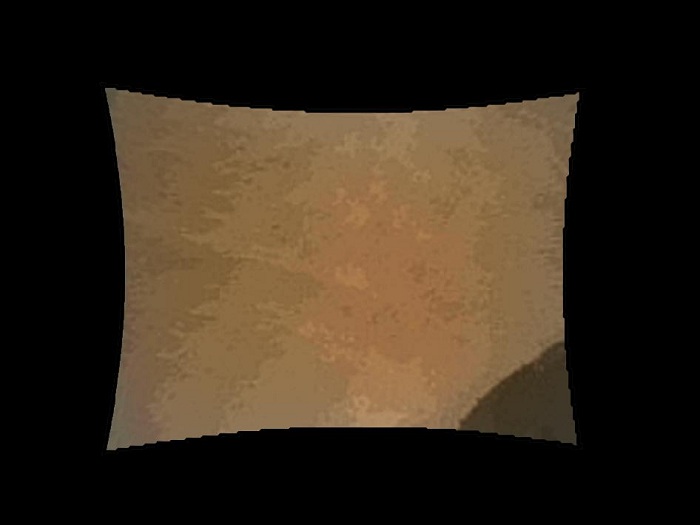
Curiosity's Wheel During Descent
The original image from MARDI has been geometrically corrected to look flat.
Curiosity landed inside of a crater known as Gale Crater.
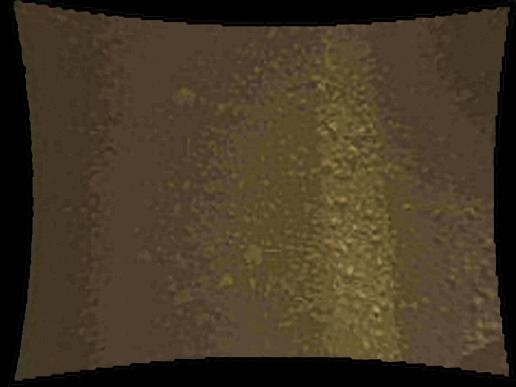
Curiosity Color Close-Up upon Landing
The original image from MARDI has been geometrically corrected to look flat.
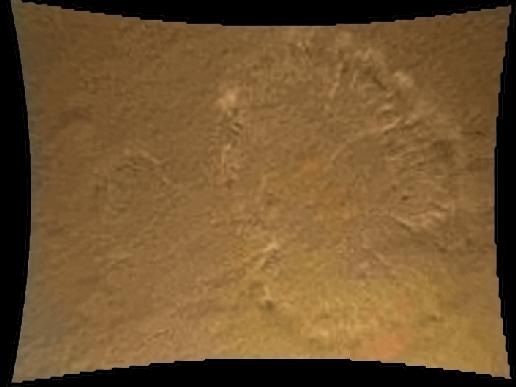
Early Color Image from Curiosity's Descent
This color thumbnail image was obtained by NASA's Curiosity rover during its descent to the surface on Aug. 5 PDT (Aug. 6 PDT). The image from Curiosity's Mars Descent Imager illustrates the roughly circular swirls of dust kicked up from the Martian surface by the rocket motor exhaust. At this point, Curiosity is about 70 feet (20 meters) above the surface. This dust cloud was generated when the Curiosity rover was being lowered to the surface while the Sky Crane hovered above. This is the first image of the direct effects of rocket motor plumes on Mars and illustrates the mobility of powder-like dust on the Martian surface. It is among the first color images Curiosity sent back from Mars.The original image from MARDI has been geometrically corrected to look flat.
